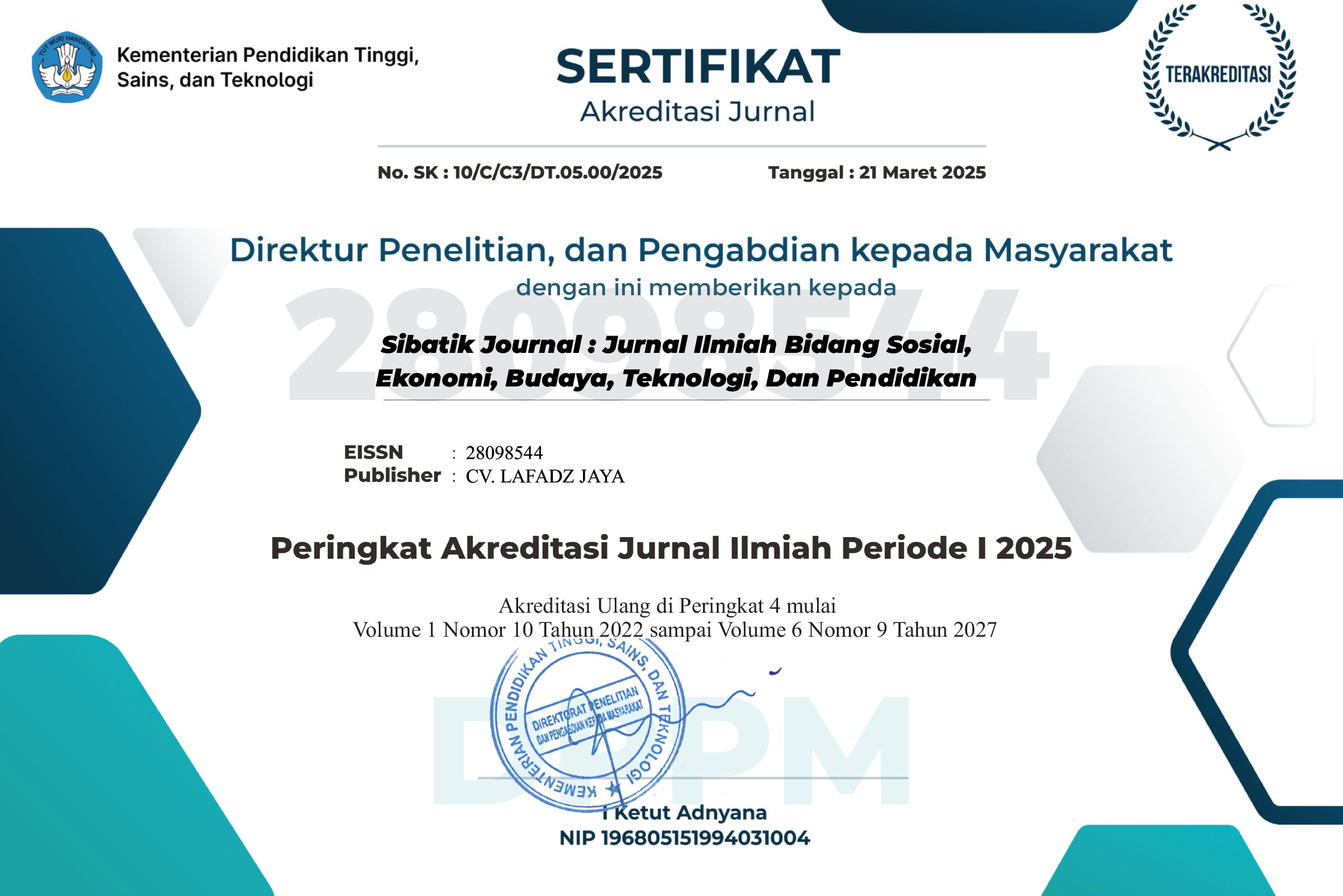THE APPLICATION OF ELECTROMEDICAL TECHNOLOGY IN MODERN HEALTHCARE SYSTEMS: CHALLENGES AND OPPORTUNITIES
DOI:
10.54443/sibatik.v3i10.2364Published:
2023-10-31Downloads
Abstract
Electromedical technology has transformed modern healthcare by enabling precise diagnostic and therapeutic tools, reducing errors, and improving patient outcomes. This paper explores the integration of electromedical devices within healthcare systems, focusing on the challenges and opportunities these technologies present. While advancements have optimized patient monitoring, treatment personalization, and medical data collection, there are still barriers to widespread adoption, including cost, regulatory compliance, and training requirements. The study investigates the current use of electromedical technology in various healthcare settings, examining case studies that highlight both its benefits and limitations. Through an in-depth review of literature and real-world applications, this research aims to offer insights into how electromedical advancements are shaping the future of healthcare. Recommendations for enhancing accessibility, safety, and efficiency of electromedical technology are also discussed, emphasizing the potential for these innovations to bridge gaps in care delivery.
Keywords:
Electromedical Technology Healthcare Systems Patient Monitoring Diagnostic ToolsReferences
Almeida, F., & Rizzo, L. (2021). Overcoming financial and regulatory barriers in healthcare technology adoption. Medical Innovation Management, 31(3), 102-118.
Baker, H., & Greenfield, A. (2019). The role of real-time monitoring in ICU settings with electromedical devices. Critical Care Innovations, 17(4), 212-229.
Chen, L., & Liu, Y. (2021). The role of pacemakers and other electromedical devices in modern healthcare. Journal of Cardiovascular Technology, 22(1), 53-69.
Garcia, M., & Patel, D. (2020). The potential of portable electromedical devices in remote healthcare settings. Remote Health Journal, 8(2), 109-122.
Green, M., Davis, T., & Owen, L. (2019). Precision medicine and the role of electromedical technology. Medical Innovations Journal, 19(3), 238-256.
Harrison, T., & Black, C. (2019). Improving diagnostic outcomes with electromedical technology in rural hospitals. Journal of Rural Health Management, 7(2), 133-145.
Hughes, P., & Davis, N. (2020). A comparative study of electromedical device regulations across continents. Journal of Regulatory Science, 10(1), 67-84.
Ikatan Elektromedis Indonesia (IKATEMI). (2024). Electromedic, Journal of Medical Electronic. Retrieved from https://jurnal.ikatemi.or.id
Kementerian Kesehatan RI. (2020). Standar profesi elektromedis: Keputusan Menteri Kesehatan RI Nomor HK.01.07/MENKES/314/2020. Sekretariat Konsil Tenaga Kesehatan Indonesia. Retrieved from https://repositori-ditjen-nakes.kemkes.go.id/295/
Kumar, A., Smith, J., & Gupta, R. (2019). Advances in electromedical imaging for diagnostics and treatment. Journal of Medical Technology, 34(2), 112-128.
Lee, K., & Park, S. (2020). Impact of MRI and CT technologies on diagnostic accuracy in healthcare. International Journal of Medical Imaging, 28(3), 145-162.
Liu, R., & Hansen, T. (2020). Best practices for electromedical device training and education in hospitals. Journal of Medical Education, 25(3), 215-230.
Martinez, J., & Zhao, Q. (2021). Data security and privacy risks in connected electromedical devices. Journal of Healthcare IT, 30(1), 122-138.
Medika Teknika: Jurnal Teknik Elektromedik Indonesia. (2024). Universitas Muhammadiyah Yogyakarta. Retrieved from https://journal.umy.ac.id/index.php/mt
Mendoza, R., & Flores, A. (2021). Electromedical technology for developing countries: Challenges and potential solutions. Journal of Global Health, 18(4), 301-319.
Moore, L., & Sinclair, J. (2021). Data privacy in the age of electromedical and connected devices. Journal of Digital Health Security, 9(2), 187-205.
Nelson, G., & Oliver, M. (2019). Impact of electromedical technology on quality of care in public health institutions. Journal of Health Policy and Quality, 32(4), 318-335.
O'Reilly, S., & Zhang, W. (2021). Cybersecurity concerns in electromedical device connectivity. Journal of Health Security, 5(3), 165-180.
Patel, S., & Rogers, D. (2020). Empowering chronic disease patients through home-based electromedical monitoring devices. Journal of Patient-Centered Care, 10(2), 87-102.
Phillips, A., & Nguyen, L. (2019). Training protocols for effective use of electromedical equipment. Journal of Clinical Training and Development, 11(3), 77-93.
Rodgers, E., Nguyen, T., & Garcia, S. (2019). Electromedical device compliance and regulatory standards: A global comparison. Healthcare Policy Review, 23(3), 110-127.
Rodriguez, E., Chandra, A., & Lopez, M. (2021). Financial barriers in the adoption of electromedical devices in low-income countries. Global Health Perspectives, 17(1), 56-70.
Simmons, D., & Williams, K. (2021). A review of wearable electromedical devices for patient monitoring. International Journal of Digital Health, 15(1), 45-59.
Smith, P., Johnson, H., & Peters, M. (2018). Reducing mortality in cardiac care through electromedical technology. Cardiology Today, 45(4), 299-315.
Standar Profesi Elektromedis: Keputusan Menteri Kesehatan RI Nomor HK.01.07/MENKES/314/2020. (2020). Repositori Ditjen Tenaga Kesehatan. Retrieved from https://repositori-ditjen-nakes.kemkes.go.id/295/
Teknologi Elektro-medis Poltekkes Kemenkes Surabaya. (2024). Retrieved from https://tekmed.poltekkesdepkes-sby.ac.id/
Thompson, G., & Bennett, R. (2022). Public-private partnerships in healthcare technology: Case studies and outcomes. Health Economics Journal, 29(2), 195-210.
Turner, B., & Walker, J. (2020). Economic implications of electromedical devices in healthcare budgets. Health Economics and Technology, 19(2), 112-128.
Walters, K., & Robinson, P. (2020). Training gaps in the use of electromedical devices among healthcare workers. Healthcare Training Journal, 11(1), 79-92.
Wu, H., & Chen, F. (2020). Addressing training needs in electromedical technology for improved patient safety. Journal of Healthcare Training, 14(2), 89-105.
License
Copyright (c) 2024 Yuris Permana Yoga Utama

This work is licensed under a Creative Commons Attribution 4.0 International License.












